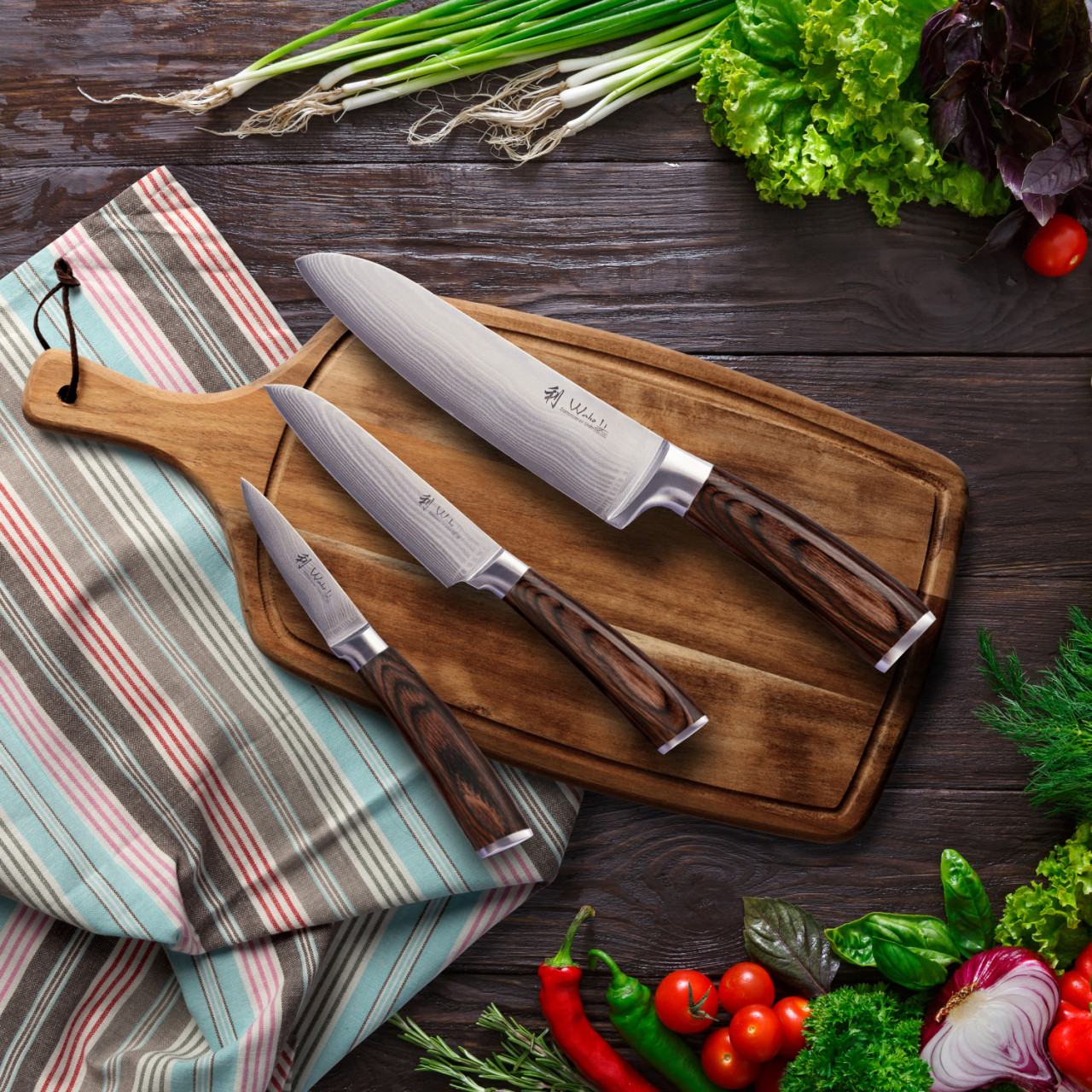Ein Messer ist eines der wichtigsten Werkzeuge in der Küche. Es gibt verschiedene Arten von Messern, die jeweils für bestimmte Aufgaben optimiert sind. Zwei beliebte Messerarten, die oft in professionellen Küchen und bei Hobbyköchen verwendet werden, sind das Kochmesser und das Santokumesser. In diesem Blogbeitrag werden wir den Unterschied zwischen diesen beiden Messern genauer betrachten und Ihnen helfen, das richtige Messer für Ihre Bedürfnisse auszuwählen.
Das Kochmesser:
Das Kochmesser ist ein vielseitiges und robustes Werkzeug, das oft als das "Allzweckmesser" in der Küche bezeichnet wird. Es verfügt über eine breite und scharfe Klinge, die sich hervorragend zum Schneiden, Hacken, Zerkleinern und Wiegen von verschiedenen Zutaten eignet. Das lange und kräftige Kochmesser ermöglicht präzise Schnitte und erleichtert das Arbeiten mit größeren Lebensmitteln wie Fleischstücken oder Kohlköpfen. Mit einem Kochmesser können Sie mühelos durch dicke Fleischstücke schneiden oder Gemüse in verschiedene Formen und Größen schneiden.
Das Santokumesser:
Das Santokumesser ist ein traditionelles japanisches Messer, das in den letzten Jahren auch in der westlichen Küche immer beliebter geworden ist. Es zeichnet sich durch eine breite, gerade Klinge aus, die etwas kürzer ist als die eines Kochmessers. Der Name "Santoku" bedeutet "drei Tugenden" und bezieht sich auf die Vielseitigkeit des Messers beim Schneiden von Fleisch, Fisch und Gemüse. Das Santokumesser hat eine hervorragende Balance und ermöglicht präzise Schnitte mit weniger Aufwand. Es eignet sich besonders gut für feinere Arbeiten wie das Schneiden von dünnen Scheiben oder das Hacken von Kräutern.
Die Unterschiede auf einen Blick:
Klinge: Das Kochmesser hat eine längere und breitere Klinge im Vergleich zum Santokumesser. Die gerade Klinge des Santokumessers eignet sich gut für präzise Schnitte, während die gebogene Klinge des Kochmessers eine größere Schneidfläche bietet.
Gewicht und Balance: Das Kochmesser ist aufgrund seiner Größe und robusteren Bauweise schwerer als das Santokumesser. Das Santokumesser ist leichter und bietet eine hervorragende Balance, was es einfacher macht, präzise Schnitte durchzuführen.
Schneidetechnik: Beim Einsatz eines Kochmessers wird oft die Wiegetechnik verwendet, bei der das Messer in einer Wiegebewegung auf und ab bewegt wird. Das Santokumesser eignet sich gut für den geraden Schnitt, bei dem das Messer einfach durch das Lebensmittel gezogen wird.
Welches Messer sollte man wählen?
Die Wahl zwischen einem Kochmesser und einem Santokumesser hängt von Ihren persönlichen Vorlieben und dem Einsatzzweck ab. Wenn Sie oft mit größeren Lebensmitteln arbeiten und eine Vielzahl von Schneidaufgaben erledigen möchten, ist ein Kochmesser eine gute Wahl. Es bietet eine breitere Klinge und robustere Konstruktion, die für verschiedene Aufgaben geeignet ist.
Wenn Sie jedoch Wert auf Präzision und feinere Schnitte legen oder gerne japanische Gerichte zubereiten, könnte das Santokumesser die richtige Wahl sein. Es ist leichter, gut ausbalanciert und ideal für präzises Schneiden von Fleisch, Fisch und Gemüse.
Fazit:
Kochmesser und Santokumesser sind beide ausgezeichnete Werkzeuge in der Küche, aber sie unterscheiden sich in ihren Eigenschaften und Einsatzmöglichkeiten. Die Wahl zwischen den beiden hängt von Ihren persönlichen Vorlieben, Ihrem Kochstil und den Aufgaben ab, die Sie häufig erledigen. Beide Messerarten können Ihnen helfen, effizient und präzise zu schneiden und das Kochen zu einem angenehmen Erlebnis zu machen.

